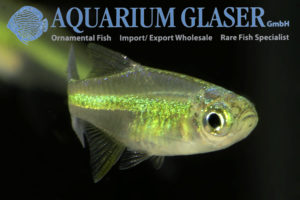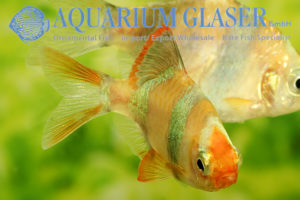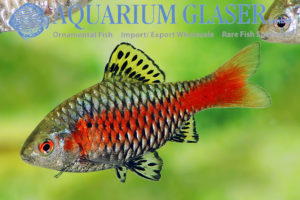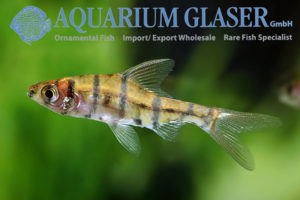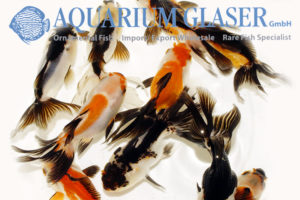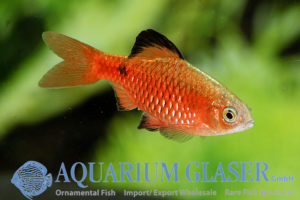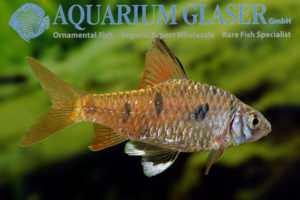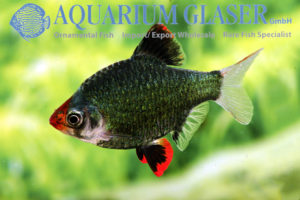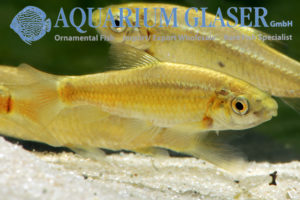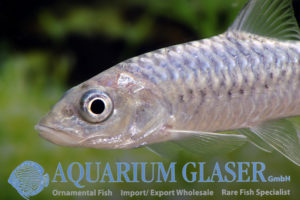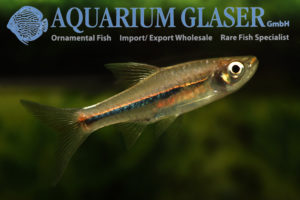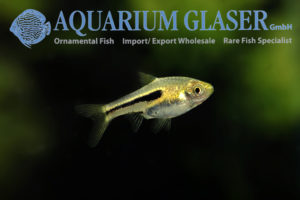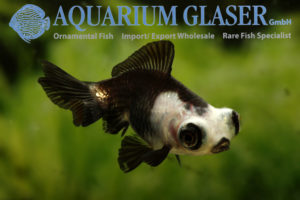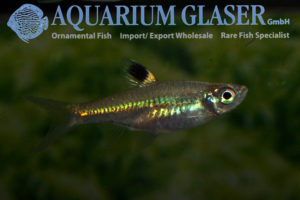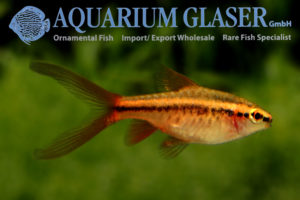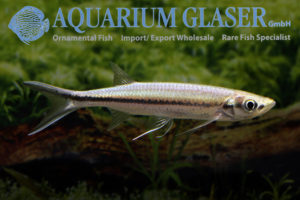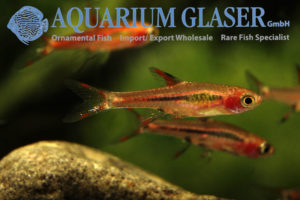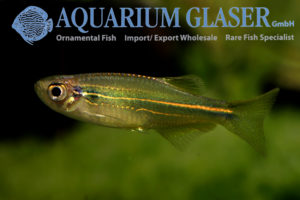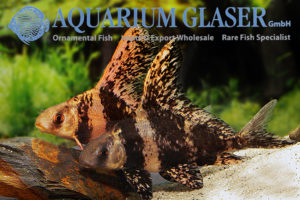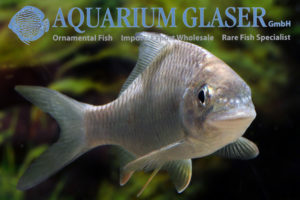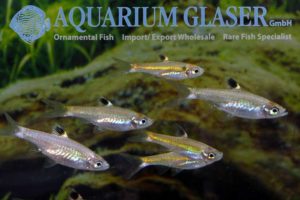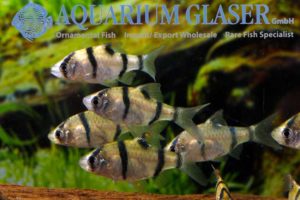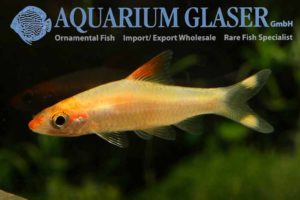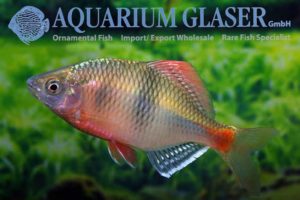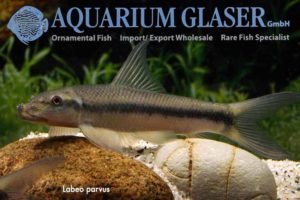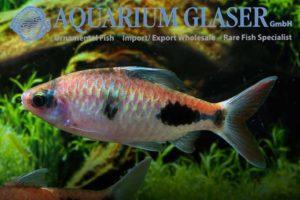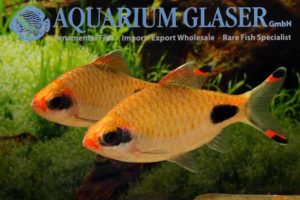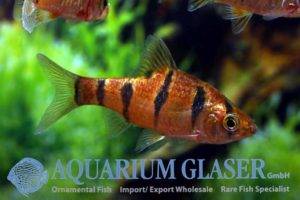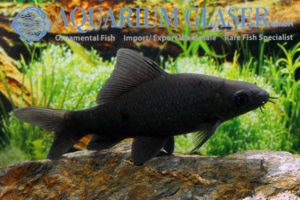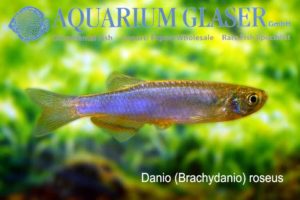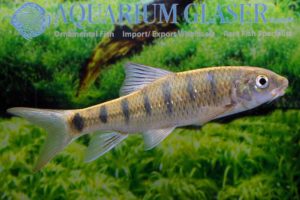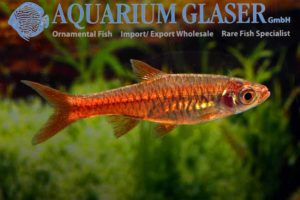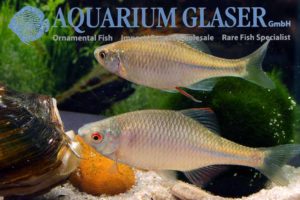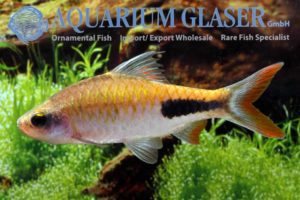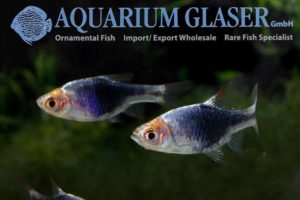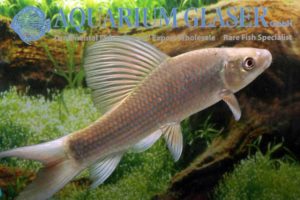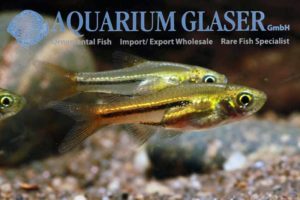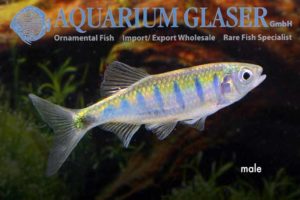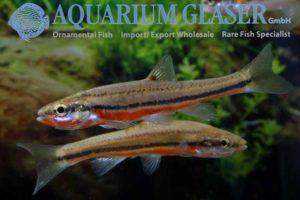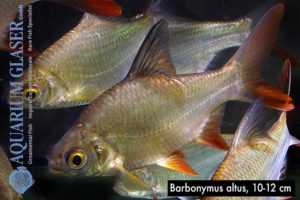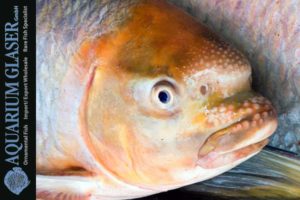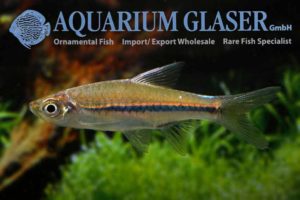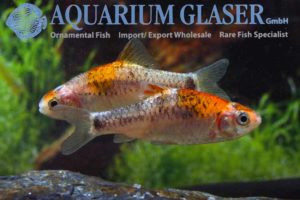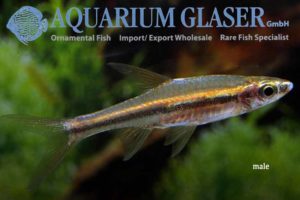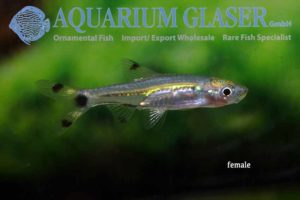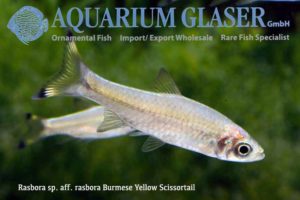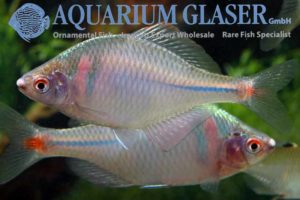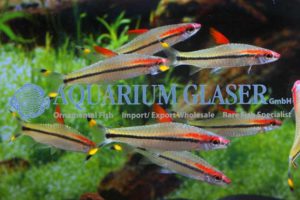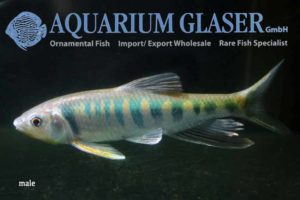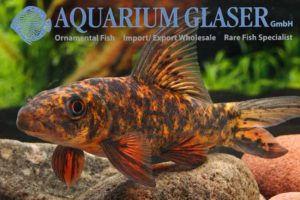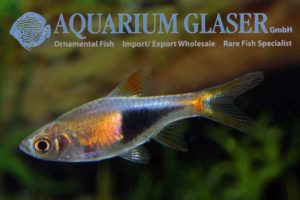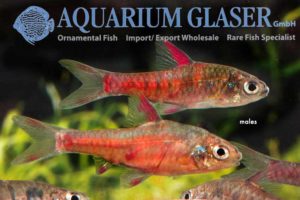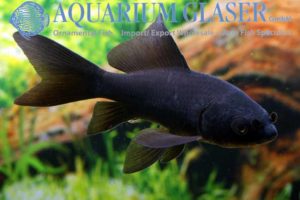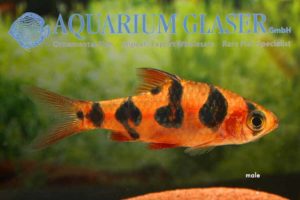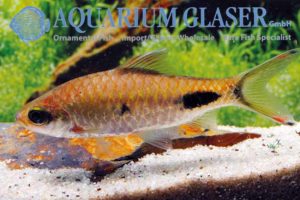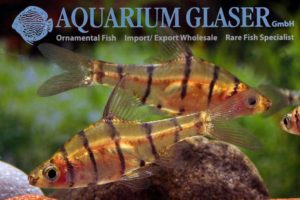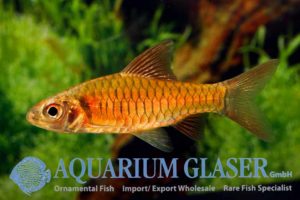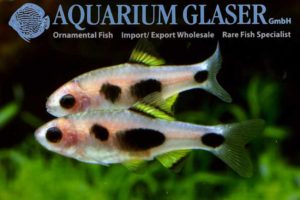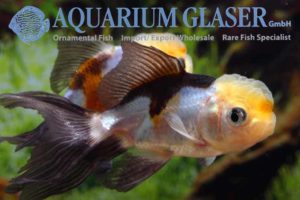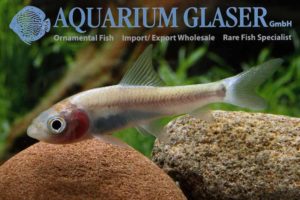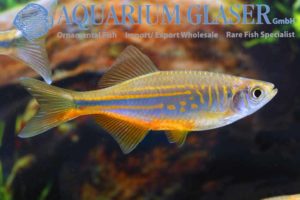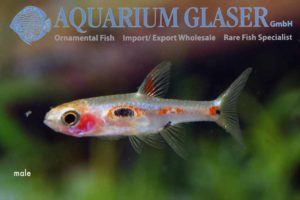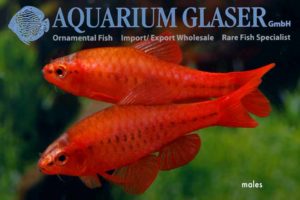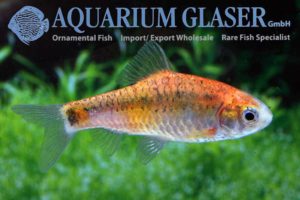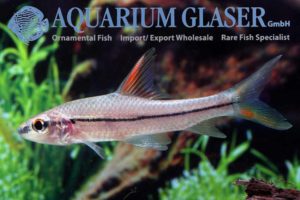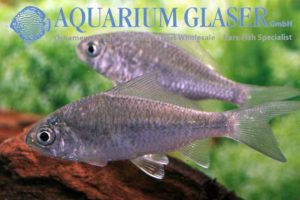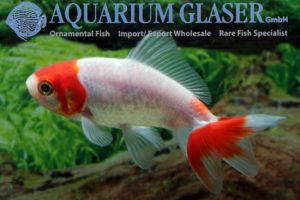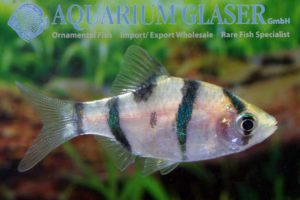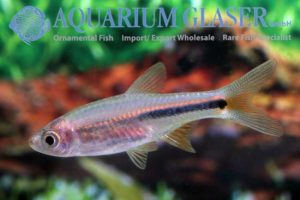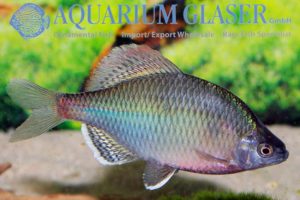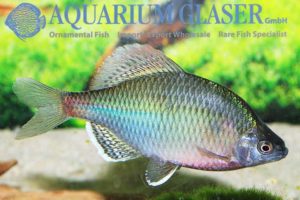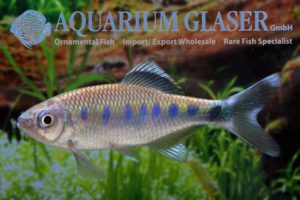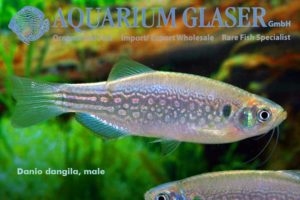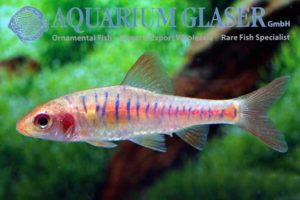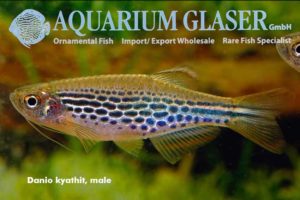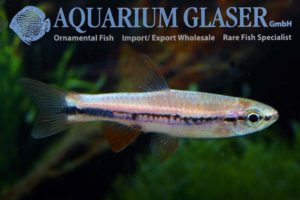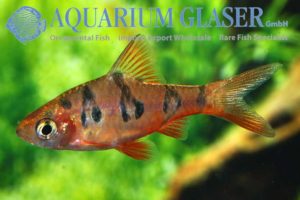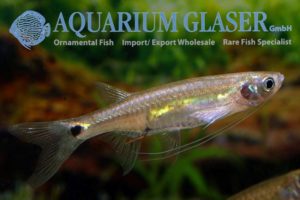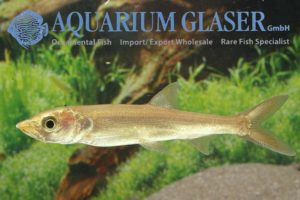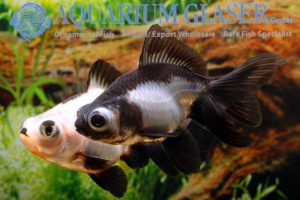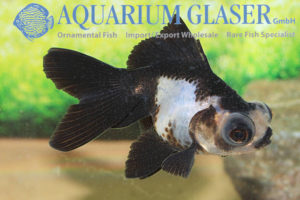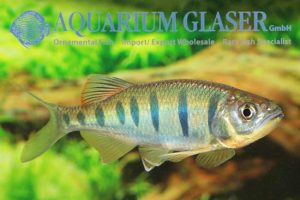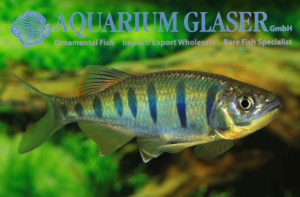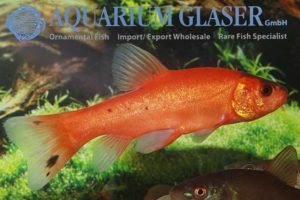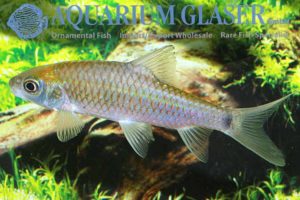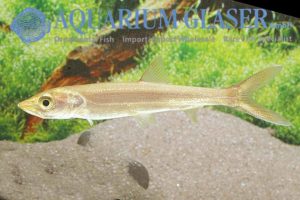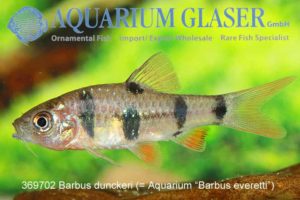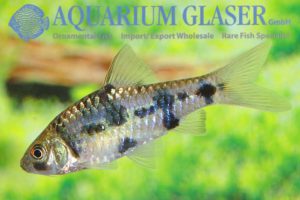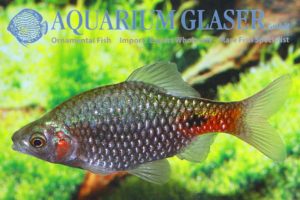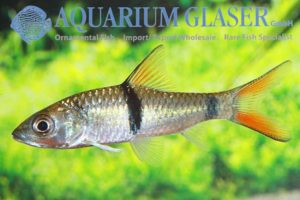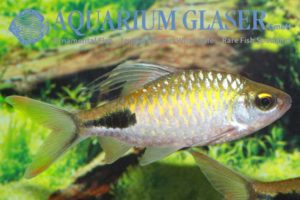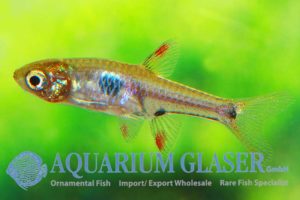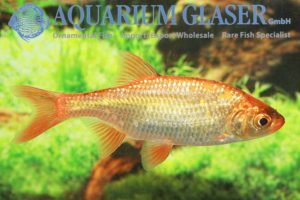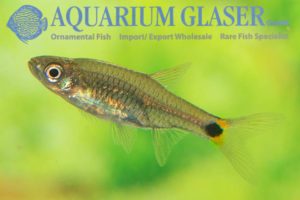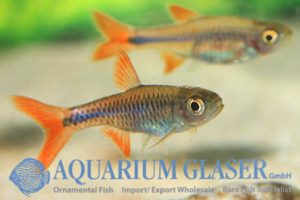Microdevario kubotai This extraordinary beauty is a real dwarf (maximum length around 2.5 cm). It originates from the southwestern province of Ranong in Thailand (which forms a border to Burma) and is now available in perfect quality. Initially this fish has been described in the genus Microrasbora, but has been transferred together with M. gatesi […]
08. Carp like fishes (2): Barbs, minnows, carps, goldfish etc. (254)
-
-
Puntigrus anchisporus (= Barbus tetrazona) Gold Green Stripe
About 10 years ago the breeders suddenly focussed again on the old-known tiger barb, whose scientific name is, by the way, Puntigrus anchisporus. Puntigrus tetrazona is a species that is practically never seen in the aquarium, the edges of its fins, which are coloured red in the tiger barb, are black. One of the new […]
-
Pethia padamya wild
The origin of the Odessa or Rubin barb was unknown for almost 30 years. The first specimens appeared in the former USSR in Odessa. It was unknown for a very long time whether they represented a wild species or an artifical breeding product. Only 2001 the first wild collected specimens could be traced. Now it […]
-
Eirmotus octozona
The Eightbanded barb (Eirmotus octozona) is a very delicate, slightly transparent dwarf barb from blackwaters of Malaysia and Indonesia. The males are much smaller than the females and sometimes even look as if they were half famished. But this is normal. Besides this males have comparatively larger ventral fins. The fish gets the most intensiv […]
-
Goldfish Oranda 2-3 Colour
In the minds of many keepers the goldfish is a coldwater fish and has its high season in spring time, when the garden pond season starts. This is of course true, but reflects only a part of the reality. The highly developed sports – like the orandas – often are better kept in aquaria than […]
-
Pethia conchonius Neon Red
The neon red ruby barb is an artifical sport of the ruby barb available for many years already. The fish are extremely beautiful; we usually obtain them from breeders from southeast Asia. Now we received this sport from an European breeder and his strain is particually beautiful. Like in the Asian cousins the flanks are […]
-
Waikhomia sahyadriensis (formerly: Barbus, Puntius)
The Khavlibarb originates from the Yenna River in Satara district in the Indian state of Marahashtra. This is a peaceful species, which could however nibble on fresh sprouts of aquarium plants. They can be kept with any peaceful tank mates without any problems. The aquarium should be decorated with robust plants and part of the […]
-
Puntigrus anchisporus „Moss Green“
Many people will still know the tiger barb under the wrong name Barbus or Puntius tetrazona. This species – the correct name is Puntigrus tetrazona – is, however, never kept in aquaria or traded, but exclusively the close relative Puntigrus anchisporus. Both species can be easily distinguished from each other by the colour of the […]
-
Garra culiciphaga
A quite new fish in the hobby is Garra culiciphaga. Initially this species has been described by the French scientist Pellegrin in 1927 under the name of Hemigrammocapoeta culiciphaga. The up to 8 cm long fish was placed in the genus Hemigrammocapoeta since 2015; recently specilaized researchers see it rather in the genus Garra. The […]
-
Tor putitora
The Mahseer carps from India are mythical fishes. They belong to the largest carp species of the subcontinent and it is said that they can reach up to 2 m in length. These carps inhabit the same ecological niches in India that are held in Europe by the salmons and trouts. Like in the latter […]
-
Rasbora sarawakensis
Once more we are able to offer that pretty Rasbora that attains a maximum length of about 5 cm. This Rasbora is a very peaceful fish that will not touch any plant in the tank. It prefers to swim in small schools along with conspecifics. R. sarawakensis feeds readily on any type of usual fish […]
-
Trigonostigma somphongsi
The Siamese Dwarf Rasbora (Trigonostigma somphongsi, formerly Rasbora somphongsi) has been described scientifically in 1958 on the basis of specimens that were imported by the ornamental fish trade by the end of 1957 from Thailand. So the exact type locality was unknown from the beginning. In the original description nothing but “Thailand” was mentioned, later, […]
-
Carassius auratus Oranda Panda
If one listens to the breeders the black and white goldfish are called „magpie goldfish“, animals with telescope eyes ae called „demekin“ and the fish with a double, but compartively small tailfin are „fantails“. An oranda, on the other hand, is a hooded fish in the language of the breeders. But honestly: who would call […]
-
Brevibora dorsiocellata
Once more we were able to import this beautiful dwarf rasbora in good numbers. Al large school of them is a fascinating look! The Eyespot Rasbora, Brevibora dorsiocellata, is a well known, classical aquarium fish. Sadly the species became almost forgotten in the 1980ies. It was Mr. Takashi Amano from Japan who was responsible for […]
-
Puntius titteya „Longfin“
Quite recently a new sport of the cherry barb, Puntius titteya, apperaed in the market. The fish are offered from Southeast Asia. We have imported them now for the very first time. A most intersting fact is that in this sport only the caudal fin is prolonged, the remaining fins have normal size. In all […]
-
Luciosoma setigerum
This barb with the extremely aerodynamic shape originates from Indonesia. Despite the size the fish can reach – up to 25 cm – the peaceful and splendid colored fish is an ideal inhabitant for a community tank with other large barbs from Asia, like Bala sharks (Balantiocheilus) or Sahyadria denisonii. For our customers: the fish […]
-
Boraras brigittae
Dieter Vogt described in 1978 a subspecies of Rasbora urophthalma (please see the entry for Boraras urophthalmoides in our fisharchives: http://www.aquariumglaser.de/en/fish-archives/boraras_urophthalmoides_formerly_rasbora_urophthalma__en/) from Borneo. He named the fish Rasbora urophthalma brigittae, a dedication name in honour for his wife Brigitte. The German name is „mosquito rasbora“. This is not because the fish are as tiny as […]
-
Danio sp. Hikari Blue & Yellow
Hikari-Danios belong to a scientifically still undescribed species of Danio from Burma. The closest relative is Danio kerri. However, Hikari danios are by far more colorful than D. kerri and really beautiful fish. Keeping and breeding Hikari Danios is absolutely comparable to the very well known zebra fish, Danio rerio. Hikari danios attain a maximum […]
-
Myxocyprinus asiaticus
We have the Chinese Whimple Carp, sometimes called the Batman-Loach, almost anytime in stock. Sadly the species is in danger of extinction in the wild, mainly due to hydroelectric power stations. All specimens traded come from aquaculture and are bred in captivity. Usually we get the fish from Singapore, but as a test we ordered […]
-
Cyprinion semiplotum
One of the advantages of the aquarium hobby is that there exists a species of fish for any thinkable taste. Most of our readers will for sure prefer the cardinal tetra, but the plump and drab coloured Cyprinion semiplotum is also worth a look. This species of carp attains a maximum length of about 60 […]
-
Brevibora dorsiocellata
The Eyespot Rasbora, Brevibora dorsiocellata, is a well known, classical aquarium fish. Sadly the species became almost forgotten in the 1980ies. It was Mr. Takashi Amano from Japan who was responsible for the comeback of the species. Amano often used a large school of B. dorsiocellata for his stylish tanks – a real eyecatcher! The […]
-
Puntigrus partipentazona
The tiger barbs were placed until recently in the catch-all genera Barbus, Puntius, or Systomus. The long time overdue splitting of the Asian small barbs led to a placement of the deep-bodied tiger barbs in a genus on their own, Puntigrus. The type species of the genus is P. partipentazona. We were able to import […]
-
Sahyadria denisonii GOLD
In any species of fish that is bred in large numbers sooner or later sports appear. This now happened also in the gorgeous Indian Redline Torpedo Shark, Sahyadria denisonii. Besides “normal” bred ones Indonesian breeders now offer a golden sport of that fish. It is obvious that the individual fish differ a lot in the […]
-
Acheilognathus macropterus – Giant Bitterling
For the first time ever we obtained this splendid bitterling via Hongkong. The species is said to become more than 25 cm long and this would make it the largest species of bitterling at all! However, our fish are currently 6-8 cm long and in full colour, so maybe more than one species is involved, […]
-
Labeo parvus and L. barbatus
Algae eaters from Africa? Hardly ever are such fish available in the trade, despite the fact that there does a high number of species exist. Currently we have two species of African Labeo in stock. There is no doubt that Labeo parvus is the better algae eater of the two. It looks astonishing similar to […]
-
Dawkinsia cf. exclamatio
We were able to import another splendid large barb from India. It belongs to the species Dawkinsia (formerly Puntius or Barbus) exclamatio or a closely related, scientifically still undescribed species. The fish are currently 8-9 cm long and are in breeding condition. Both sexes show now a red back, the males also develop “spawning pimples” […]
-
Dawkinsia assimilis
In South India a group of barbs exists that was formerly placed either in Barbus or in Puntius and which is now placed in the only recently (2012) erected genus Dawkinsia. In Dawkinsia a phenomenon exists that aquarists are used to know for example from cichlids from Lake Malawi: every new collecting site reveals a […]
-
Desmopuntius hexazona wild
The banded barbs from Southeast Asia were always matters of interest, both of aquarists and scientists. The generic position of the species was unclear for quite a long time: they were placed in Barbus, Puntius, or Systomus. But t seems that the problems has been solved finally. The elongated species are now placed in the […]
-
Labeo chrysophekadion
The black shark is of course no shark at all, but a cyprinid or carp. It is a very large growing species, attaining almost a metre in length and 7 kg in weight. Like many other large carps it is a very much sought for food fish in Southeast Asia. So it is bred in […]
-
Danio (Brachydanio) roseus
The pearl danio (Brachydanio albolineatus) is the type species of the (sub-)genus Brachydanio. It belongs to the most popular species of ornamental fish in the world and is almost anytiome available in any petshop. However, the other Bracydanio in the closer sense are by far less well known. Among them is Brachydanio roseus that originates […]
-
Acrossocheilus paradoxus
We received this interesting fish from Taiwan. It can be kept as well in unheated aquaria as in garden ponds. The species usually attains a length around 12 cm. This means that our specimens are adult already. Maximum size recorded is around 20 cm. Males have a by far larger anal fin than the females. […]
-
Rasbora vulcanus
This Rasbora originates from the west coast of Sumatra. It attains a maximum length of about 5 cm. The “hot” name of the species is not only a reminder on the volcanos in the area, where R. vulcanus appears, but also due to the bright red-orange colours the males develop during mating. The females are […]
-
European Bitterling – Rhodeus amarus
The Bitterling of Central Europe is a small cyprinid, reaching a total length of 6-8 cm. It is very famous, because it lays its eggs as a parasite of freshwater mussels in the gills of living mussels. The behaviour accompanying this parasitic breeding strategy is extremely interesting and makes the Bitterling an ideal aquarium or […]
-
Dawkinsia rohani (formerly: Barbus or Puntius rohani)
Once more we were able to import this gorgeous, medium sized barb – it attains a length of 8-12 cm – from southern India. For more informations on the species seehttp://www.aquariumglaser.de/en/fish-archive/barbs-asboras-danios-en/Dawkinsia_formerly_Barbus_rohani_en/. The photos show a mating male (recognizable by the tubercles on the snout and the red caudal fin) of our current importation. For our […]
-
Trigonostigma heteromorpha Blue and Gold
The Harlequin barb (Trigonostigma heteromorpha) belongs to the most popular ornamental fish worldwide. The beautiful colours and the peaceful mood make them ideal inhabitants of a community tank. One can hardly believe today that once it was impossible to breed that species. In the 1930ies the breeders hard to learn that water chemistry can be […]
-
Labeo coubie
The great variety of species of Labeo from Africa is hardly known in the hobby. Even for scientists the determination is difficult. Only in 1990 a new species was detected in the Niger basin! This brings the number of Labeo-species known from the Niger to four: Labeo parvus, L. roseopunctatus, L. senegalensis, and L. coubie. […]
-
Trigonostigma somphongsi
The Siamese Dwarf Rasbora (Trigonostigma somphongsi, formerly Rasbora somphongsi) has been described scientifically in 1958 on the basis of specimens that were imported by the ornamental fish trade by the end of 1957 from Thailand. So the exact type locality was unknown from the beginning. In the original description nothing but “Thailand” was mentioned, later, […]
-
Opsarius bernatziki
For the first time ever we could import this pretty barb from Thailand. At first we thought the fish would belong to the species Opsarius ornatus, but after they has settled all of our fish showed a clearly marked caudal spot, which is typical for O. bernatziki, but lacking in B. ornatus. Another very similar […]
-
Chrosomus erythrogaster
We can offer only very rarely wild collected fishes from the USA. But currently we have some species of minnow in stock, among them the very pretty Chrosomus erythrogaster. These fish do not need a heater, but feel also very comfortable at temperatures over 24°C. Maximum size for that species is 10-12 cm, currently the […]
-
Barbonymus altus and B. schwanefeldii
Two beautiful species of barb are continiously confused in the ornamental fish trade, because they look much alike as juveniles: Barbonymus altus and B. schwanefeldii. Both are known in the international trade as “tinfoil barbs”. In German they are named “bream barb” what refers to the deep body of adult fish. The main differences in […]
-
Bangana behri
For the first time ever we were able to import a quite bizarre species of carp from Southeast Asia: Bangana behri. This up to 45 cm long relative of Labeo has in adult state a horn on the head and a lot of tubercles in the face. In its native range – the Mekong basin […]
-
Rasbora sarawakensis
The genus Rasbora is a very specious one and contains currently 82 described species. Nevertheless only comparatively few species have been ever kept in aquaria. R. sarawakensis reaches about 5 cm in length and originates from a part of Borneo that belongs to Malaysia. We were able to import the pretty schooling fish, which is […]
-
Brokatbarbe KOI
The Golden barb is an artificial sport that is said to have derived from the half-banded barb (Barbus semifasciolatus). However, nobody can say this for sure. The fish appeared in the 1960ies in the aquarium trade and is said to have been bred by an aquarist named Thomas Schubert of Camden, New Jersey, US. That […]
-
Trigonopoma gracile (= Rasbora taeniata)
We could import this pretty fish finally once more via Singapore. The two species of the genus Trigonopoma were placed in the genus Rasbora for a very long time. The second species, T. pauciperforata, the glowlight rasbora, occurs interestingly very often syntopically with its close relative. In die elder aquarium literature Trigonopoma gracile was usually […]
-
Rasbosoma spilocerca
This dwarf rasbora becomes only about 3 cm long. The species is new in our stocklist. The scientific description of the fish was under the name of Rasbora spilocerca, but nowadays it is placed in the monotypic (this means the genus contains only one species) genus Rasbosoma. The natural distribution of the charming fish is […]
-
Rasbora sp. Burmese Yellow Scissortail
We obtained for the first time ever a small number of a new species of Rasbora from Burma. The new fish is without any doubts a close relative of the Indian species Rasbora rasbora but differs in details of the tail fin pattern. Currently our fish are 3-4 cm long. For our customers: the fish […]
-
Rhodeus ocellatus
When the talk is about bitterlings one initially thinks for the European Bitterling, Rhodeus amarus, which is currently banned in the UK. In fact, there are more than 70 species of these fascinating brood parasites that deposit their eggs in live freshwater mussels. We were able now to import a species of bitterling from Hongkong […]
-
Phantastic wild collected Sahyadria denisionii from Karnataka!
The Red line shark (Sahyadria denisonii, formerly known as Barbus denosonii or Puntius densonii) is a very popular aquarium fish. Currently it is traded almost exclusively as bred specimens from Indonesia. For the first time ever we now received an import of S. denisonii from a new collection area in India. So far the species […]
-
Zacco platypus – large males arrived!
Currently we can offer large, 12-15 cm long males of this spectacular species of barb that reached us from Hongkong. Zacco are coldwater fish that can be kept either in unheated aquaria or in garden ponds. They love strong current! Smaller specimens (7-10 cm, both sexes) are also in stock. For our customers: the fish […]
-
Labeo variegatus
After a long time we were able once again to import this beautiful species of Labeo from the Congo. Scientifically speaking, the name “variegatus” is regarded only as a synonym of Labeo cyclorhynchus nowadays. However, it is pretty difficult to substitute a well known name – like Labeo variegatus – in the aquarium hobby by […]
-
Trigonostigma heteromorpha
Genetic investigations showed that there is not only one species of harlequin barb, but a number of sibling species, which have to be described scientifically yet. This becomes very obvious when we come across wild collected specimens. The depicted animal, for example, is a wildcaught from southern Thailand. It is much more elongate than the […]
-
Barbus jae
Barbus jae is one of the smallest species of barb from Africa. It has been described from the river Dja in Cameroon. Sadly nowadays imports from Cameroon are very rare, so one has to be really lucky to find this jewel in a local pet shop. B. jae becomes only 2-3 cm long. Breeding B. […]
-
Carassius auratus – Comet Black
We received this sport of the goldfish from China. The animals are suited not only for the garden pond (they are completely winterhardy), but look also very nice in lateral view. For our customers: the fish have code 808202 on our stocklist. Please note that we exclusively supply the wholesale trade. Text & photos: Frank […]
-
Desmopuntius rhomboocellatus
We obtained extremely beautiful, fully grown specimens of the Orange barb. We want to take the opportunity to bespeak one more of the numerous changes in genus names in small barbs from Asia. Desmopuntius – the name means “prisoner-barb” and refers to the striped pattern that is shown by all species included at least as […]
-
Dawkinsia sp. aff. exclamatio
Once more we were able to import this impressive barb from South India. It is a very close relative of D. exclamatio, but differs in details of coloration. For our customers: the fish have code 369666 on our stocklist. Please note that we exclusively supply the wholesale trade. Available in very limited numbers only! Text […]
-
Eirmotus octozona
This tiny barb is very enigmatic. It has been described in 1959 on the basis of specimens from the aquarium fish trade which were said to originate from Thailand (Bung Borapet). However, there have been no reports since then about any occurence of Eirmotus in Thailand. Oramental fish collectors formerly collected this species in the […]
-
Clypeobarbus congicus
The Copper-red Congobarb is astonishingly only an insider tip among aquarists and even experienced hobbyists often never have heard of it. This beautiful fish attains a maximum length of only 4-5 cm, only in rare exceptions they become up to 7 cm long. These barbs are absolutely peaceful schooling fish. Currently we can offer the […]
-
Barbus hulstaerti Lompole
Once more we received a small jewel from the Congo basin. Again, a somewhat larger number of the Butterfly Barb Barbus hulstaerti could be imported, which was lost in the hobby for a long time. The colour variety with the large spot on the side is called “Lompole” after the collection site. The lively fish […]
-
Goldfish Oranda Tricolor
In the minds of many keepers the goldfish is a coldwater fish and has its high season in spring time, when the garden pond season starts. This is of course true, but reflects only a part of the reality. The highly developed sports – like the orandas – often are better kept in aquaria than […]
-
Labeo boga
Fresh fish can be most easily recognized by the red gills. Thus the Labeo boga, which we currently obtained from India, must be very fresh. Why the gill covers in this peaceful, schooling species, which can attain a length of about 30 cm and is a much sought for food fish in its home county, […]
-
Devario malabaricus
The Giant or Malabar Danio is one of the most popular aquarium fish at all. The species takes some time to settle when brought in a a new tank and until then it looks a bit silvery. But when the males get in brooding mood they leave no doubts why this species of fish is […]
-
Boraras merah
Wir haben derzeit bildhübsche Boraras merah im Stock. Die Art ist sehr eng mit B. brigittae verwandt und zumindest in manchen Populationen sehen die Weibchen wie B. brigittae aus, die Männchen wie B. merah (siehe auch http://www.aquariumglaser.de/fischarchiv/barben-baerblinge-danios/Boraras_brigittae_Boraras_merah_de/). Bei der jetzt importierten Population scheinen aber beide Geschlechter in B.-merah-Färbung vorhanden zu sein. Für unsere Kunden: die […]
-
Barbus titteya Super Red
The Cherry barb, Barbus titteya, is a favorite aquarium fish for decades already. The species is quite variable regarding coloration in the wild already. It lives endemic on the island of Sri Lanka. The sport called Super Red has been developed by selective breeding. Currently we can offer very beautiful animals from a German breeder. […]
-
Golden barb Koi
The Golden barb is an artificial sport that is said to have derived from the half-banded barb (Barbus semifasciolatus). However, nobody can say this for sure. The fish appeared in the 1960ies in the aquarium trade and is said to have been bred by an aquarist named Thomas Schubert of Camden, New Jersey, US. That […]
-
Cyclocheilichthys janthochir
For the first time ever we have this beautiful species of shark in stock. Of course it belongs to the barb family, but species of several barb genera that have a similar body shape, are commonly called “shark” in the hobby. In our fishhouse it got the nickname “top-model-barb”, for it is very pretty, but […]
-
Cyprinion semiplotum
One of the advantages of the aquarium hobby is that there exists a species of fish for any thinkable taste. Most of our readers will for sure prefer the pretty Pseudomugil cf. paskai, but the plump and drab coloured Cyprinion semiplotum is also worth a look. This species of carp attains a maximum length of […]
-
Wakin Goldfish Hoe Kim
One of the earliest sports that developed in goldfish is the double tailfin. Simple goldfish with a double tailfin are called Wakin. Red-and-white pattern belongs to the most popular and most beautiful colour sports in goldfish. Red-and-white fish are called in general Sarasa. The Wakin Sarasa is also called Wakin Hoe Kim. Wakin goldfish are […]
-
Barbus partipentazona
Finally we received wild collected specimens of this pretty barb again. Maximum size, keeping etc. is exactly as in the well known tiger barb. Barbus partipentazona originates from the south of Thailand. For our customers: the fish have code 370603 on our stocklist. Please note that we exclusively supply the wholesale trade. Text & photos: […]
-
Rasbora paucisqualis
It does not happen very often that we feel unable to determine an imported species at least roughly. But when a few weeks ago a shipment containing very small (about 1 cm) Rasboras from Thailand arrived we could name the fish only provisionally “Rasbora sp. Dwarf”. In the meantime the fish have grown happily and […]
-
Acheilognathus tonkinensis
We received breathtaking, large Acheilognathus tonkinensis (Giant or Rainbow Bitterling). Fot more information, please click http://www.aquariumglaser.de/en/fish-archive/coldwater-fish/Acheilognathus_tonkinensis_en/For our customers: the animals have code 800154 on our stocklist. Please note that we exclusively supply the wholesale trade. Text & photo: Frank Schäfer
-
Acheilognathus tonkinensis
The bitterlings are a subfamiliy of the great and diverse carp family. So far only very few species have been introduced in the hobby, but there do exist about 70 species and subspecies which are classified in 4 genera. It is a sad thing that only so few aquarists are interested in bitterlings, for all […]
-
Barilius bakeri
We could import this breathtaking beautiful barb from the South of India (Kerala). The species is an ideal ornamental fish for larger show aquaria. It attains a length of 12-15 cm. One should keep Barilius bakeri always in schools (from 5 specimens upwards), otherwise they are often very quarrelsome. For our customers: the fish have […]
-
Danio dangila
We received once more very pretty Danio dangila from India. This species is the type species of the genus Danio. D. dangila attains a maximum length of about 12 cm. Each individual has a bit different pattern. The coloration reminds one in Damascus steel. For our customers: the fish have code 413403 on our stocklist. […]
-
Barbus fasciolatus
Only very few species of barbs from Africa became established as ornamental fish, although a great number of small species occurs there. Only one single species is bred on a regular basis and can be found in the trade quite often: Barbus fasciolatus, the African banded barb. This fish is a real beauty! A well […]
-
Danio kyathit and Danio quagga
We received fantastic wild collected fish of both species of Danio from Burma. They are close relatives of the well known zebra fish (Danio rerio), reach a comparable size and can be kept and bred in the very same way. Danio quagga has been thought to be a mere variety of D. kyathit for a […]
-
Chela cachius
This pretty flying barb is imported only very occasionally. It originates from the north of India. The species attains a length of about 5 cm and is a peaceful schooling fish that uses to swim in the upper layers of the water column. The coloration of Chela cachius is very interesting. If there is a […]
-
Rasbora patrickyapi
For the first time ever we can offer this beautiful species of blackwater Rasbora. The fish attains a maximum length of about 5 cm. In its natural habitat the species is restricted to peat swamps in the central parts of Kalimantan (the Indonesian part of Borneo). Here the pH is very low. Nevertheless the species […]
-
Barbus rhomboocellatus
We received wonderful wild collected specimens from Borneo. The males have a lot of red in their basic coloration. Keeping and breeding are comparable to the better known close relative, Barbus pentazona. For our customers: the animals have code 370923 on our stocklist. Please note that we exclusively supply the wholesale trade. Text & photos: […]
-
Esomus caudiocellatus
The Flying barbs of Southeast Asia represent the same type of fish as the Hatched fishes do in South America. For the first time ever we have the pretty Esomus caudiocellatus from Burma in stock. The absolutely peaceful species attains a maximum length of about 5-6 cm. For our customers: the fish have code 415592 […]
-
Elopichthys bambusa
Owing to the great demand we have stocked the last specimens available from our supplier in Taiwan now. These specimens of the gorgeous predator are probably the last ones available for quite a long time. For more information, please check http://www.aquariumglaser.de/en/news/Elopichthys_bambusa_en/ For our customers: the fish have code 414903 on our stocklist. Please note that […]
-
Oranda Panda
Once more we received a nice shipment of this very striking black-and-white sport of the goldfish. For our customers: the fish have code 817502 on our stocklist. Please note that we exclusively supply the wholesale trade. Text & photo: Frank Schäfer
-
Oranda Panda
Code number: 817503 Photo: Frank Schäfer
-
Opsarius pulchellus
This is one of the most beautiful new entries in the hobby in the past few years. However, the species is known scientifically already since 1931, when Hugh M. Smith, one of the greatest experts for the fishes of Thailand, described the species. And even Smith observed the extraordinary beauty of the fish and named […]
-
Opsarius pulchellus
We received wonderful, about 6-8 cm long Opsarius pulchellus from Thailand. The common name “Butterfly danio” reflects perfectly all the beauty of this grace. Read more on the fish here: http://www.aquariumglaser.de/en/opsarius-pulchellus_de_1355.html For our customers: the animals have code 439904 on our stocklist. Please note that we exclusively supply the wholesale trade. Text & photos: Frank […]
-
Tinca tinca GOLD
The gardenpond season starts up! The Tench, a species initially native in Europe and western Asia, is a perfect pond and aquarium fish. Nowadays the Tench has a worldwide distribution, because it is a very delicious food fish, too. The Tench is very tolerant regarding the water temperature: it is totally winter hardy on the […]
-
Spinibarbus denticulatus
We have this large barb that originates from the south of China and the north of Vietnam in stock for the first time. The usual length of the fish is up to 40 cm. At this length they weigh about 1.5 kg. However, the largest S. denticulatus captured so far had a weight of about […]
-
Elopichthys bambusa
For the first time ever we received youngsters of this highly interestingly fish species. Maximum length reported for Elopichthys is about 2 m. This species is one of the very few real predators among the carp-like fish. Currently the genus Elopichthys is regarded to be monotypical, but there might exist a second species in the […]
-
Barbus dunckeri (= aquarium “Barbus everetti”)
-
Barbus everetti “Real”
The island of Borneo is divided, politically speaking, in three parts: Kalimantan belongs to Indonesia, Sarawak and Sabah belong to Malaysia and Brunei represents an independent state. Kuching is the biggest town on Borneo. It is located in the northwest, in Sarawak (Malaysia). Ornamental fish are collected there only very occasionally. However, recently we were […]
-
Barbus conchonius
You think you know quite well the rosy barb? Please take a look on our photos of the fantastic wild collected ones we currently have in stock and think about it. In fact wild collected rosy barbs – our specimens originate from the vicinty of Calcutta, the type locality of Barbus conchonius – look completely […]
-
Hampala macrolepidota
There are only very few predatory species among the barbs. Like all Cyprinidae, they do not have teeth in their jaws, but only in the throat. So it is not that easy for a barb to fix a food fish. Among the rare exceptions are the barbs of the genus Hampala. There are 6-7 accepted […]
-
Dawkinsia (formerly Barbus) rohani
It was only last year that this beautiful Indian barb has been described scientifically. It originates from the south of India. Presently it is only known from hill streams in the Kanyakumari District, Tamil Nadu. It differs from the other Indian barbs of its closer relationship (eg D. arulius, D. assimilis, D. exclamatio, D. filamentosa, […]
-
Boraras naevus
The dwarf rasbora that is traded under the name of “Boraras micros RED” for some years already, has been described now scientifically and has been named Boraras naevus. The species is distinguished from all other spotted Boraras species known so far by the sexual dichromatism. The B. naevus males develope a much bigger shoulder spot […]
-
Scardinius erythrophthalmus GOLD
Scardinius erythrophthalmus GOLD The rudd (Scardinius erythrophthalmus) is the only species of freswater fish native in Central Europe that is specialized in feeding on soft water plants and algae. Thus it is a perfect helper for garden ponds where algae and especially duckweed should be reduced. As the rudd likes to swim in the upper […]
-
Rasbora brittani
At the first glimpse this pretty Rasbora may look a bit colorless; however, if the fish is kept in the perfect milieu (blackwater conditions and dimmed light) it looks really beautiful. Due to a number of anatomical specializations, the species has been recently placed in a new genus, namely Kottelatia; so the most actual scientific […]
-
Rasbora lacrimula
Rasbora lacrimula For the first time ever we can offer this beautiful Rasbora, which has been described scientifically only in 2009. R. lacrimula is endemic in the Mahakam basin, Kalimantan Timur Province on Borneo. Regarding coloration this new Rasbora reminds one in R. reticulata and R. vulcanus, but R. lacrimula stays much smaller. Maximum length […]
A new algae-eater from Burma: Garra vittatula

We abtained for the first time ever this species of Garra. In this genus it is currently impossible to guarantee the exact determination of the species, for a hughe number of species is described and most of them look extremely similar to each other. Our fish at least are very close to G. vittatula.

All species of Garra are good algae eaters and are usually kept rather for that purpose than due to the coloration. However, well established G. vittatula look quite attractive, maybe because they often show a reddish caudal fin. There is one very obvious behaviour in G. vittatula: it is extremely social. The specimens regulary search for conspecifics. So this species should be kept in small schools composed of at least 5 specimens. Maximum size reported for Garra vittatula in scientific literature is about 6-8 cm, so our specimens are probably fully grown already.



For our customers: the fish have code 416433 on our stocklist. Please note that we exclusively supply the wholesale trade.
Text & photos: Frank Schäfer
American Gold Minnows from Florida arrived

Finally we can offer again the pretty golden sport of the Fathead minnow Pimephales promelas. This fish is the ideal inhabitant of small garden ponds. For more informations on the species see http://www.aquariumglaser.de/en/pimephales-promelas-natur–gold_de_1339.html

For our customers: the animals have code 870002 on our stocklist. Please note that we exclusively supply the wholesale trade.

Text & photos: Frank Schäfer
Small goldfish Ranchu, mixed colours

Now
is the best season for buying young goldfish. The animals have spend
the summer in growing ponds and are in top condition now. Of course most
hobbyists ask for goldfish in springtime, this has a long tradition.
But one should keep in mind that in spring time the fish come from an
exhausting hibernation and that makes them quite sensitive. So, whoever
is interested in goldfish is well advised to look for them right now.


Currently
we have imported for example pretty young ranchus in mixed colours from
Hongkong. One thing have goldfish and koi in common: among thousands of
animals are only very few that fulfil the high demands of a breeder.
But all of them are healthy and strong fish!


For our customers: the animals have code 818001 on our stocklist. Please note that we exclusively supply the wholesale trade.
Text & photos: Frank Schäfer
Newly arrived: Notropis chrosomus

We have received a good number of this extremely beautiful fish from our proved breeder. For further information, please check http://www.aquariumglaser.de/en/notropis-chrosomus-_de_1010.html.


For our customers: the fish have code 439391 on our stocklist. Please note that we exclusively supply the wholesale trade.
Text & photos: Frank Schäfer





